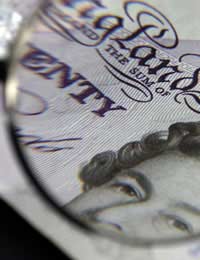Recgonising and Handling Counterfeit Currency

Probably the first thing that springs to mind when the word counterfeiting is mentioned is currency. Not coins – they’re not worth the effort – but paper money, especially £10, £20 and £50 notes.
Counterfeiting does go on, tending to be in different areas at different times, as the criminals hit a region, pass off the notes, then move on fairly quickly before they can be caught. The ones who suffer, of course, are the shopkeepers, particularly small shopkeepers, who are on the receiving end of the fake notes. They’re usually used to buy small value items, so the crooks receive plenty of real money in their change, and not attract too much attention.
It’s a constant battle between those who design and print the notes and the counterfeiters, who have become more and more sophisticated. The notes have become more complex over the years, employing everything from silver threads to holograms in a bid to outfox those who’d copy them.
Many of us will never see a counterfeit note, at least not to our knowledge, although, with plenty in circulation, we might have had one in our wallets or purses at some time. But how would we really know? How do you identify a fake bank note?
How To Identify A Fake
You’ll probably have seen sales assistants in shops holding notes up to the light. That’s to check the watermark. Every note should have one, and it should be a portrait of the Queen, easily identifiable in the paper. If it’s not there, then the note is a fake, as plain and simple as that, which is why checking is such as simple test.
Genuine notes have a very thin strip of silver running vertically through the note. When held up to the light it looks solid, but when the note is pressed flat it looks as if it’s been sewn through (which it effectively has, just to make things harder for the counterfeiters).
All notes should have a serial number, which can be printed horizontally or vertically, and the number should only be for that note. If you receive two with the same serial number – then they’re counterfeit.
The newer the note – that lovely crisp feel – the more it should have a certain roughness over the printing, and the edges should be sharp. The printing on the note itself should be very well-defined. Of course, as note designs change it can be hard to keep track, so anyone dealing with money regularly needs to be aware of all the changes before they happen.
There are devices you can buy to help spot the fakes, ultraviolet lights and special pens. However much they’re touted, though, the police insist they’re not completely foolproof and need to be used as part of a total approach – including visual inspection – to check whether a note is real.
What If You Find A Fake
If you accidentally receive a bank note that you suspect is a fake, you need to take it to the police. Trying to spend it is against the law, and if caught you could conceivably end up in court. You probably won’t be recompensed for turning the note in, but you will be doing your duty – and staying on the right side of the law!
- Fake Weddings Cakes
- Which Countries Produce the Most Counterfeits?
- How Countries Are Battling Counterfeit Drugs
- How to Spot Fake Charities
- Do You Buy Fakes?
- China and the Counterfeit Problem
- Who Buys Fakes?
- The Penalty for Adulterated Milk
- Recognising an Email as Spam
- Bogus Workmen and Your Rights
- How to Spot Fake Identification
- Consumer Rights - What Can You Do If You've Purchased Counterfeit Goods?
- Your Rights As A Consumer - How To Make A Complaint
- Counterfeiting and Copyright - Protecting Your Intellectual Property
- The Fake Antique Market
- Fake Aeroplane Parts and Illegal Counterfeiting
- Fake Food and Drink
- Counterfeit Auto Accessories
- The Business in Fake Car Parts
- The Dangers of Fake Medications


Re: Counterfeit Cigarettes On The Market
In the uk Richmond Original king size or super kings If it says Richmond blue FAKE…
Re: Your Rights As A Consumer - How To Make A Complaint
Hi, I purchased a pair motorcycle pants form an online company Custom Jacket Co, they registered at…
Re: Consumer Rights - What Can You Do If You've Purchased Counterfeit Goods?
Was sold counterfeit jewellery items although stated in the ad that it…
Re: Consumer Rights - What Can You Do If You've Purchased Counterfeit Goods?
I recently bought five Momo carbon fibre steering wheels off a person on…
Re: Consumer Rights - What Can You Do If You've Purchased Counterfeit Goods?
I bought about 70 goods from 5 star costemics on May 26, 2020, and when I…
Re: Counterfeit Cigarettes On The Market
I have been buying what I think is Richmond Blue from a local shop at full market price but they keep going out, are…
Re: Counterfeit Cigarettes On The Market
Started using a cigarette case as new packs horrible, noticed varying filter lengths Marlboro red from local shop,…
Re: Counterfeit Cigarettes On The Market
If governments around the world didn't keep restricting tobacco, and making prices become insanely high, then there…
Re: Counterfeit Cigarettes On The Market
Bought Sterling reds in Tenerife from a shop stating 100% genuine. Sterling logo on cigarette is red; when I buy in UK…
Re: Counterfeit Cigarettes On The Market
I have purchase a pack of the fake cigarettes. They taste bad plus I felt kind of dizzy afterwardso. They are all over…